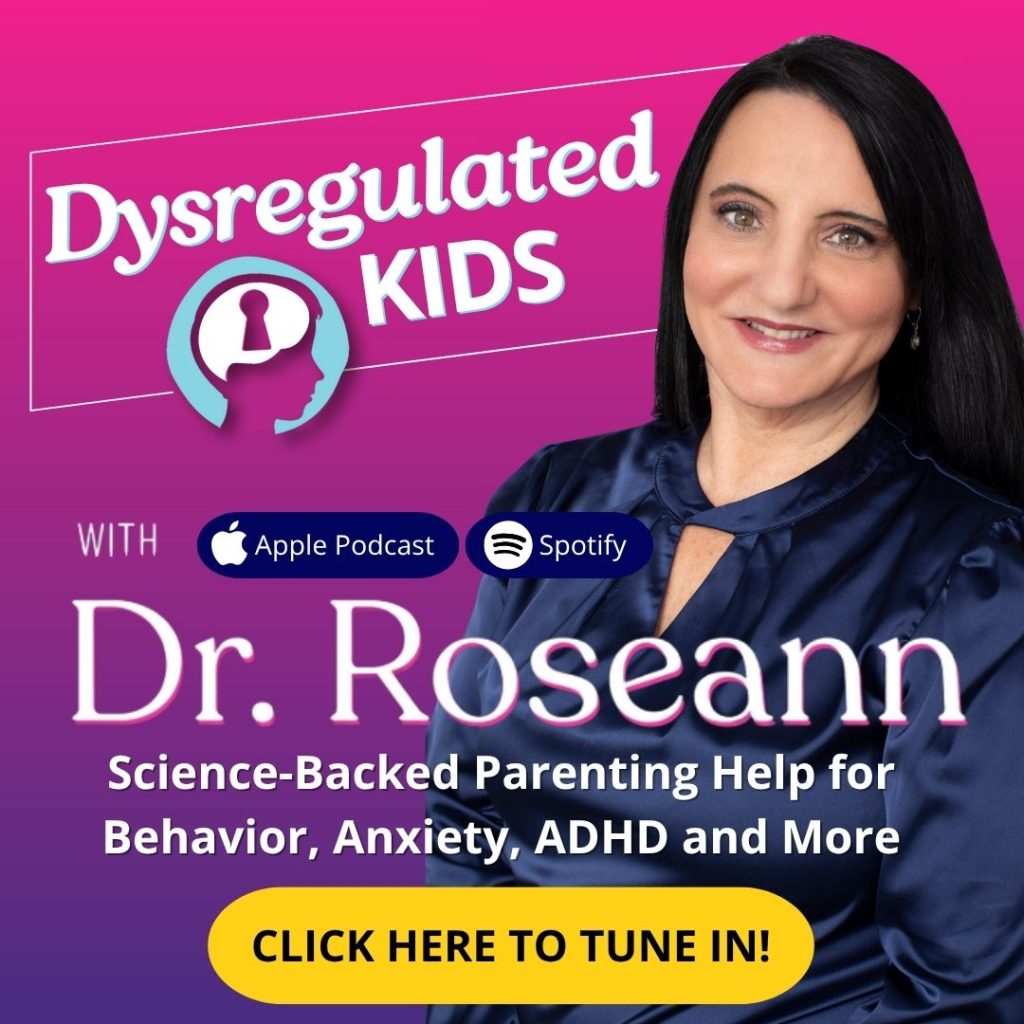Estimated reading time: 5 minutes
Many loving parents feel that same heartbreak and frustration when parent and child communication breaks down.
The truth? When stress hijacks the brain, logic and empathy shut down—for both parent and child. These breakdowns aren’t just emotional; they’re neurological. They’re signs of dysregulation in the brain and nervous system—and when we calm the brain first, connection naturally follows.
Why Does Parent and Child Communication Break Down?

When communication falters, it’s rarely about defiance—it’s about dysregulation.
When either the parent’s or the child’s nervous system is stuck in fight, flight, or freeze, connection takes a backseat to survival. You’re not failing—it’s simply a sign that the brain needs calm before conversation.
Common Reasons Why Parent and Child Communication Breaks Down:
1. Lack of Active Listening
- Distraction blocks connection. When parents multitask or half-listen, kids feel unheard and stop sharing.
- Even a few minutes of focused attention can rebuild trust (McNaughton & Vostal, 2010).
Common causes include:
- Mental overload or burnout
- Constant correction or reactivity
- Too many competing demands pulling your attention away
Takeaway:
Presence is powerful. Ten calm minutes beat an hour of distracted talking.
2. Criticism and Negativity
- Kids shut down when they feel judged.
- Repeated correction sends the message, “I’m not good enough.” Over time, that shame response activates their stress system and builds a wall between you.
Try instead:
- Catch them doing something right
- Acknowledge effort, not just outcomes
- Replace “Don’t do that” with “Let’s try this”
Calm correction builds confidence—and confidence keeps communication open.
Read more:
3. Low Empathy
- Stress limits empathy. When parents are overwhelmed, the brain shifts from connection to protection.
- Children who sense emotional distance often retreat or shut down.
Strengthen empathy by:
- Regulating your own nervous system first
- Listening without rushing to fix
- Naming feelings (“That sounds really frustrating”)
Research shows parental empathy directly supports children’s emotional regulation and brain development (Swain et al., 2017).
You can’t pour from an empty cup—your calm fuels theirs.
4. Different Communication Styles
- Some kids need quiet time to process; others talk nonstop. Neither is wrong—it’s just how their brain works.
- For children already overloaded by school pressure or sensory input, even gentle questions can feel like “too much.”
Meet them where they are by:
- Giving introverted kids space before talking
- Offering expressive kids structure for when and how to share
- Adapting your tone and pacing to their state of regulation
Behavior is communication. Adjust your rhythm, and connection follows.
5. Unresolved Conflict
- Disagreements are normal—but yelling or shutting down triggers survival mode.
- Kids with ADHD, anxiety, or mood issues may not yet have the impulse control or coping skills to handle conflict calmly.
Model co-regulation through:
- Steady tone and slower breathing
- Taking short breaks when emotions rise
- Revisiting issues once everyone is calm
You can’t correct until you regulate and connect. Calm must come first.
6. Busy, Stressful Lives
- Overscheduled days drain patience and presence.
- When you’re running on empty, your nervous system sets the emotional thermostat for the whole family.
Make time for calm by:
- Building short daily rituals of connection
- Prioritizing rest over perfection
- Remembering: you can’t co-regulate from chaos
Calm homes aren’t perfect—they’re intentional.
7. Technology Overload
- Screens are today’s biggest conversation thief.
- Parents and kids often scroll instead of speak, trading real connection for digital noise.
Reconnect by:
- Putting phones down during meals
- Choosing device-free moments for meaningful talk
- Engaging when both brains are calm—not mid-game or mid-scroll
Replace “screen time” with “seen time.”
8. Changing Developmental Stages
- As kids grow, they test independence and boundaries. It’s not rejection—it’s development.
- Staying curious instead of defensive helps communication evolve with them
Keep connection through:
- Asking open-ended questions
- Respecting their growing need for privacy
- Offering guidance without judgment
Curiosity keeps the door open—even when your teen closes theirs.
At the heart of it all, remember: Behavior is communication.
A slammed door or eye roll isn’t disrespect—it’s a nervous system saying, “I don’t feel safe.”
Let’s calm the brain first, and connection will always follow.
How Does Dysregulation Affect Communication?
When the nervous system is overstimulated, even simple conversations can feel unsafe. Both you and your child may react as if under threat.
What You Will Notice:
- Quick defensiveness or sudden silence
- Big emotions over small issues
- “I don’t care” or avoidance responses
- Trouble following directions or showing empathy
This isn’t disrespect. It’s neuroscience. Stress hormones hijack reasoning while instincts take over, so calm first, talk later.
Even tiny gestures can melt tension like sunlight through fog. True change comes not from lectures but from presence, patience, and nervous system alignment (Sacu et al., 2025).
How Can Parents Rebuild Communication After It Breaks Down?
In my Regulation First Parenting™ framework, healing always begins with three steps:
1. Regulate – Calm the Brain First
- Start by calming your own nervous system. Model slow breathing or gentle touch before talking.
- If you’re triggered, step away and reset—you can’t co-regulate from chaos.
2. Connect – Build Safety
- Use eye contact, a soft tone, and validation: “I can see this is hard for you.”
- Drop judgment—curiosity opens doors that criticism slams shut.
3. Correct – Teach Once Calm
- Guide problem-solving and set boundaries after both nervous systems are settled.
- Because you can’t correct until you regulate and connect—calm must always come first.
How to Talk to Your Teen When They Refuse to Communicate
Teens crave autonomy but still need emotional safety. When conversations feel like interrogations, they retreat — not because they don’t care, but because their nervous system is saying, “I need space to feel safe.”
Try Instead:
- Ask, don’t accuse: “You seem off today. Want to talk or just hang out?”
- Respect quiet: Silence can be regulation time.
- Use parallel talk: Connect during shared activity—car rides, cooking, walks.
Parent Story:
Mark, father of a 15-year-old with ADHD, shared: “When I stopped lecturing and started listening during basketball practice, he finally started talking again.”
Connection grows in low-pressure moments — when the brain feels calm and safe.

What Role Does the Parent’s Nervous System Play?
Your calm is your child’s cue for safety. When you’re tense, their brain mirrors it through a process called co-regulation.
Parent Regulation Tips:
- Practice slow breathing (inhale 4 sec / exhale 6 sec).
- Lower your voice when theirs rises.
- Use grounding: feel your feet, notice your breath.
What Are Practical Ways to Improve Communication at Home?
Create a Calm Environment
- Keep routines predictable — structure helps the nervous system feel safe.
- Use visual schedules to make transitions smoother.
- Limit multitasking and background noise so everyone’s brain can rest.
Use Brain-Calming Language
- Swap “What’s wrong with you?” for “What’s happening in your body right now?”
- Use “we” language. “We’ll figure this out together.” It reminds your child they’re not alone.
Try Regulation Tools That Support the Brain and Body
- Movement breaks to reset the nervous system
- walk
- stretch
- dance
- Sensory input
- weighted blankets
- soft lighting
- calming textures
- Brain-based supports to help the brain return to balance
- neurofeedback
- CALM PEMF™
- magnesium
- quality sleep
Remember, calm doesn’t happen by accident — it’s something we create through consistency, connection, and daily regulation.
When Should I Seek Professional Help?
If conversations keep spinning out despite your best calm-first efforts, it might be time to take a closer look at what’s happening inside your child’s brain. Sometimes, their nervous system just needs extra help finding steady ground again.
Signs It’s Time to Seek Guidance:
- Arguments that flare instantly—or sudden shutdowns that freeze the room
- Anxiety creeping in, sadness that lingers, or flat-out school refusal
- Frequent meltdowns, retreating into rooms, or losing interest in things they usually love
Tools like QEEG brain mapping or neurofeedback can reveal hidden patterns of dysregulation and guide a path back toward calm and focus.
You’re not failing—really. Your child’s brain simply needs a little coaching to rediscover its balance.
Thinking about bringing calm home? The BrainBehaviorReset™ Program blends science and compassion to help your child—and you—regulate, reconnect, and thrive.
Because when we calm the brain first, everything else begins to follow. Behavior is communication—and nervous system regulation is the solution.
Parent Action Steps
FAQs
Why does my child ignore me when I try to talk?
Your child’s brain may be stuck in fight, flight, or freeze. Start by calming your own body and voice—once safety returns, they’re more ready to listen and engage.
How can I stop every talk from turning into a fight?
Pause before reacting. Use regulation strategies like deep breathing or stepping away briefly, then return once both of you feel calm. Calm brains create space for real conversation.
What if my teen only talks to friends, not me?
This is developmentally normal. Stay present and consistent without pressure. Showing up calmly over time rebuilds trust and opens doors for meaningful dialogue.
Does yelling make communication worse?
Yes. Raised voices trigger stress responses in your child’s nervous system. Soft, steady tones calm the brain and invite listening instead of resistance.
Can supplements help calm my child’s brain?
Sometimes. Magnesium, omega-3s, and stable blood sugar can support regulation. Always check with a healthcare provider before adding supplements to your child’s routine.
Citations
McNaughton, D., & Vostal, B. R. (2010). Using active listening to improve collaboration with parents: The Laff don’t Cry strategy. Intervention in School and Clinic, 45(4), 251-256. https://doi.org/10.1177/1053451209353443
Sacu, S., Hermann, A., Banaschewski, T., Gerchen, M. F., & Holz, N. E. (2025). The long-term correlates of developmental stress on whole-brain functional connectivity during emotion regulation. Translational psychiatry, 15(1), 152. https://doi.org/10.1038/s41398-025-03374-8
Swain, J. E., Ho, S. S., Rosenblum, K. L., Morelen, D., Dayton, C. J., & Muzik, M. (2017). Parent-child intervention decreases stress and increases maternal brain activity and connectivity during own baby-cry: An exploratory study. Development and psychopathology, 29(2), 535–553. https://doi.org/10.1017/S0954579417000165
Always remember… “Calm Brain, Happy Family™”
Are you looking for SOLUTIONS for your struggling child or teen?
Dr. Roseann and her team are all about solutions, so you are in the right place!
Grab your complimentary copy of
©Roseann Capanna-Hodge











